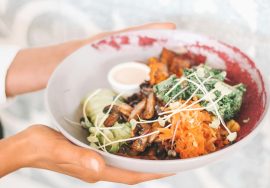
Global Bites: Exploring Culture Through 5 Iconic Street Foods
Street food is more than just a quick meal on a busy afternoon — it’s an edible snapshot of a culture, a living tradition handed down through generations and served hot in the open air. While fine dining often gets the spotlight in the culinary world, the real heart and soul of a nation’s cuisine can often be found sizzling on a roadside grill, bubbling in a steaming pot, or tucked into a paper wrapper. The experience of eating street food is immersive: the clatter of pans, the aromas wafting through narrow alleys, the chatter of locals grabbing their favorite snacks. It’s food that connects people, invites curiosity, and offers travelers one of the most authentic tastes of a place.
In this journey through five cities and five legendary street foods, we explore not only what’s on the plate — but what it says about the people who make and love it.
- Mexico City, Mexico – Tacos al Pastor
If there’s one street food that encapsulates the bold, layered flavors of Mexican cuisine, it’s tacos al pastor. You’ll find them being sliced from vertical spits in street corners across Mexico City — a rotating pillar of marinated pork, its edges crisped by flame, its core tender and juicy. Tacos al pastor are typically served on small corn tortillas, topped with diced onions, chopped cilantro, a sliver of grilled pineapple, and a splash of spicy salsa.
This taco is more than just delicious — it tells a story of cultural fusion. The technique of spit-roasting meat was introduced to Mexico by Lebanese immigrants in the early 20th century, and the local adaptation eventually gave rise to al pastor. The dish is a perfect example of how migration influences food — and how flavor becomes the universal language everyone understands.
Grab one late at night in the bustling Roma neighborhood or near the markets of Coyoacán, and you’re not just eating a taco — you’re experiencing the way Mexico embraces its past, welcomes its present, and feeds its future.
- Bangkok, Thailand – Pad Thai
Pad Thai may be Thailand’s most famous export, but nothing compares to the experience of eating it streetside in Bangkok. The scent of stir-fried noodles, fish sauce, garlic, and lime hits you long before you reach the cart. Cooked to order in a large, seasoned wok, the dish combines rice noodles with egg, tofu or shrimp, bean sprouts, and crushed peanuts. Served with a lime wedge and a dash of chili flakes, it’s a balance of sweet, sour, salty, and spicy — a cornerstone of Thai cuisine.
Interestingly, pad Thai’s rise to prominence isn’t purely organic. During the 1930s and ’40s, Thailand’s government encouraged its citizens to embrace rice noodles over rice to boost national rice exports. What began as a state-sponsored campaign has since become a beloved staple.
Eating pad Thai from a cart tucked into a narrow Bangkok alley is more than a meal — it’s a taste of resilience and resourcefulness, of how a nation turned a political decision into a globally adored dish. It’s fast, flavorful, and fiercely local.
- Istanbul, Turkey – Simit
Not all street food needs to be bold and spicy to make an impression. In Istanbul, simit — a circular bread encrusted with sesame seeds — is a daily ritual, often enjoyed with tea or a chunk of feta cheese. Simit vendors are everywhere: in subway stations, on street corners, and walking through traffic with trays balanced on their heads.
Though it might be tempting to compare simit to a bagel, this Turkish staple has a lighter, crispier texture and a subtly sweet flavor thanks to the molasses glaze it’s dipped in before baking. It’s often eaten on the go, and its popularity spans generations and social classes. Whether you’re a student rushing to class or a businessman heading to the office, simit is the city’s great culinary equalizer.
Istanbul’s simit tells a quieter story — one of daily life, of comfort and consistency in a city that straddles two continents and countless centuries of history. It’s the kind of food that doesn’t scream for attention, but once you try it, you understand why it’s never gone out of style.
- Mumbai, India – Vada Pav
In Mumbai’s relentless buzz — the traffic, the crowds, the color — vada pav is the fuel that keeps the city moving. This iconic street food is essentially a deep-fried spiced potato fritter (vada) tucked inside a soft white bun (pav), often slathered with chutneys and dusted with garlic masala. It’s simple, satisfying, and sold at thousands of tiny stalls throughout the city.
Vada pav has its roots in the working-class neighborhoods of Mumbai and was once considered a meal for laborers — cheap, filling, and easy to eat with one hand. But over the decades, it has transcended class lines. Today, everyone eats vada pav, from schoolkids to CEOs. Its affordability and ubiquity have made it both a symbol of Mumbai’s egalitarian food culture and a beloved comfort food for millions.
To eat a vada pav standing on a curb as the monsoon rain begins to fall is to understand a slice of what it means to live in Mumbai: chaotic, flavorful, and never standing still.
- Tokyo, Japan – Takoyaki
At first glance, takoyaki might look unassuming — just round balls of dough, crisped on the outside and gooey within. But one bite reveals a burst of texture and umami. Inside each ball is a piece of tender octopus, surrounded by a batter laced with scallions and pickled ginger. They’re topped with a generous drizzle of tangy takoyaki sauce, Japanese mayo, dried seaweed, and bonito flakes that sway and dance from the heat.
Takoyaki originated in Osaka but has become a staple of street food culture across Japan, particularly in Tokyo’s vibrant neighborhoods like Shibuya and Asakusa. Cooked in special molded pans, takoyaki is often made to order, flipped skillfully with metal picks in rapid, practiced movements.
This dish represents Japan’s obsessive attention to detail, its celebration of umami, and the communal spirit of snacking. Street vendors call out to passersby, and people gather around steaming grills, waiting for their batch of golden balls. It’s social food, meant to be eaten hot and fresh, surrounded by the energy of the crowd.
Food as Passport, Street as Table
What connects these five dishes — beyond their irresistible flavors — is their ability to tell stories without words. Each one is a bite-sized history lesson, a record of migration, adaptation, survival, and celebration. Street food reflects what people value: speed, comfort, nostalgia, creativity, community.
Unlike food served behind closed doors in high-end restaurants, street food is immediate and accessible. It invites you in, often for just a few coins, and offers something personal. You might not know the language or the customs of a new country, but if you can eat what the locals eat, you begin to understand their rhythm.










